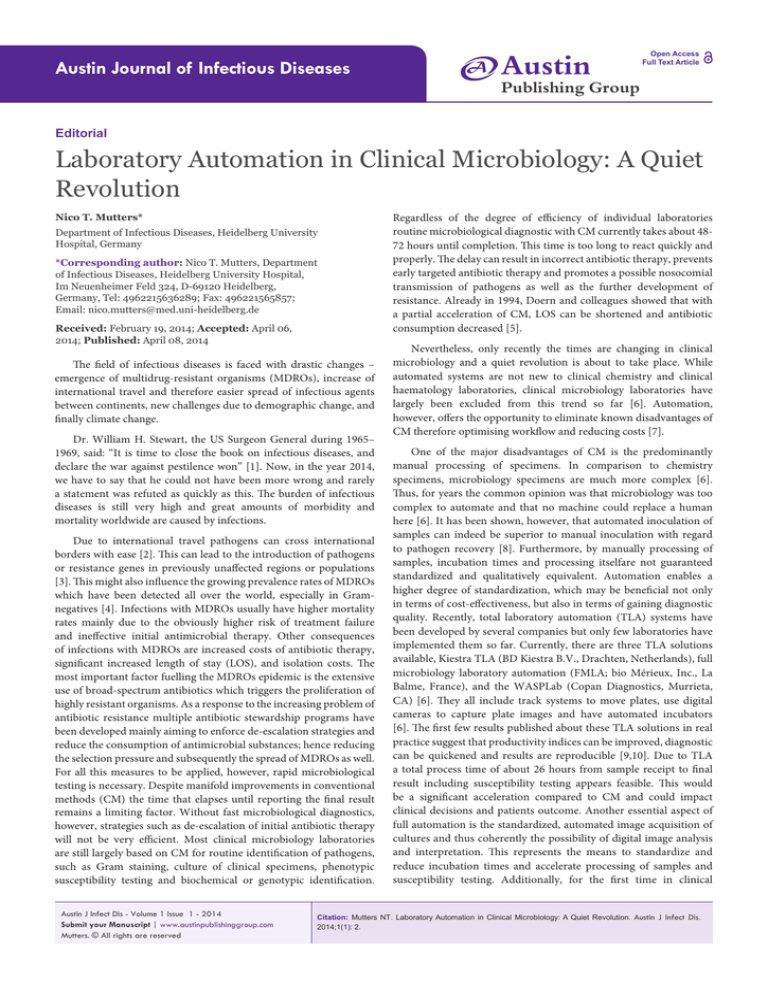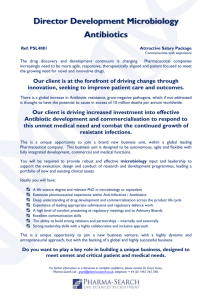
Austin Journal of Infectious Diseases
A
Austin
Open Access
Full Text Article
Publishing Group
Editorial
Laboratory Automation in Clinical Microbiology: A Quiet
Revolution
Nico T. Mutters*
Department of Infectious Diseases, Heidelberg University
Hospital, Germany
*Corresponding author: Nico T. Mutters, Department
of Infectious Diseases, Heidelberg University Hospital,
Im Neuenheimer Feld 324, D-69120 Heidelberg,
Germany, Tel: 4962215636289; Fax: 496221565857;
Email: nico.mutters@med.uni-heidelberg.de
Received: February 19, 2014; Accepted: April 06,
2014; Published: April 08, 2014
The field of infectious diseases is faced with drastic changes –
emergence of multidrug-resistant organisms (MDROs), increase of
international travel and therefore easier spread of infectious agents
between continents, new challenges due to demographic change, and
finally climate change.
Dr. William H. Stewart, the US Surgeon General during 1965–
1969, said: “It is time to close the book on infectious diseases, and
declare the war against pestilence won” [1]. Now, in the year 2014,
we have to say that he could not have been more wrong and rarely
a statement was refuted as quickly as this. The burden of infectious
diseases is still very high and great amounts of morbidity and
mortality worldwide are caused by infections.
Due to international travel pathogens can cross international
borders with ease [2]. This can lead to the introduction of pathogens
or resistance genes in previously unaffected regions or populations
[3]. This might also influence the growing prevalence rates of MDROs
which have been detected all over the world, especially in Gramnegatives [4]. Infections with MDROs usually have higher mortality
rates mainly due to the obviously higher risk of treatment failure
and ineffective initial antimicrobial therapy. Other consequences
of infections with MDROs are increased costs of antibiotic therapy,
significant increased length of stay (LOS), and isolation costs. The
most important factor fuelling the MDROs epidemic is the extensive
use of broad-spectrum antibiotics which triggers the proliferation of
highly resistant organisms. As a response to the increasing problem of
antibiotic resistance multiple antibiotic stewardship programs have
been developed mainly aiming to enforce de-escalation strategies and
reduce the consumption of antimicrobial substances; hence reducing
the selection pressure and subsequently the spread of MDROs as well.
For all this measures to be applied, however, rapid microbiological
testing is necessary. Despite manifold improvements in conventional
methods (CM) the time that elapses until reporting the final result
remains a limiting factor. Without fast microbiological diagnostics,
however, strategies such as de-escalation of initial antibiotic therapy
will not be very efficient. Most clinical microbiology laboratories
are still largely based on CM for routine identification of pathogens,
such as Gram staining, culture of clinical specimens, phenotypic
susceptibility testing and biochemical or genotypic identification.
Austin J Infect Dis - Volume 1 Issue 1 - 2014
Submit your Manuscript | www.austinpublishinggroup.com
Mutters. © All rights are reserved
Regardless of the degree of efficiency of individual laboratories
routine microbiological diagnostic with CM currently takes about 4872 hours until completion. This time is too long to react quickly and
properly. The delay can result in incorrect antibiotic therapy, prevents
early targeted antibiotic therapy and promotes a possible nosocomial
transmission of pathogens as well as the further development of
resistance. Already in 1994, Doern and colleagues showed that with
a partial acceleration of CM, LOS can be shortened and antibiotic
consumption decreased [5].
Nevertheless, only recently the times are changing in clinical
microbiology and a quiet revolution is about to take place. While
automated systems are not new to clinical chemistry and clinical
haematology laboratories, clinical microbiology laboratories have
largely been excluded from this trend so far [6]. Automation,
however, offers the opportunity to eliminate known disadvantages of
CM therefore optimising workflow and reducing costs [7].
One of the major disadvantages of CM is the predominantly
manual processing of specimens. In comparison to chemistry
specimens, microbiology specimens are much more complex [6].
Thus, for years the common opinion was that microbiology was too
complex to automate and that no machine could replace a human
here [6]. It has been shown, however, that automated inoculation of
samples can indeed be superior to manual inoculation with regard
to pathogen recovery [8]. Furthermore, by manually processing of
samples, incubation times and processing itselfare not guaranteed
standardized and qualitatively equivalent. Automation enables a
higher degree of standardization, which may be beneficial not only
in terms of cost-effectiveness, but also in terms of gaining diagnostic
quality. Recently, total laboratory automation (TLA) systems have
been developed by several companies but only few laboratories have
implemented them so far. Currently, there are three TLA solutions
available, Kiestra TLA (BD Kiestra B.V., Drachten, Netherlands), full
microbiology laboratory automation (FMLA; bio Mérieux, Inc., La
Balme, France), and the WASPLab (Copan Diagnostics, Murrieta,
CA) [6]. They all include track systems to move plates, use digital
cameras to capture plate images and have automated incubators
[6]. The first few results published about these TLA solutions in real
practice suggest that productivity indices can be improved, diagnostic
can be quickened and results are reproducible [9,10]. Due to TLA
a total process time of about 26 hours from sample receipt to final
result including susceptibility testing appears feasible. This would
be a significant acceleration compared to CM and could impact
clinical decisions and patients outcome. Another essential aspect of
full automation is the standardized, automated image acquisition of
cultures and thus coherently the possibility of digital image analysis
and interpretation. This represents the means to standardize and
reduce incubation times and accelerate processing of samples and
susceptibility testing. Additionally, for the first time in clinical
Citation: Mutters NT. Laboratory Automation in Clinical Microbiology: A Quiet Revolution. Austin J Infect Dis.
2014;1(1): 2.
Nico T. Mutters
Austin Publishing Group
microbiology, TLA solutions introduce a quality assurance tool that
allows even after a long time to assess bacterial growth retrospectively.
Furthermore, TLA enables centralized virtual lab for outlying posts in
remote areas, thus avoiding quality losses by long transport times.
However, they are also drawbacks to automation in clinical
laboratory. Until now, scientific research assessing the benefits of
automation in clinical microbiology is scarce. Is there really a benefit
for the patient when diagnostic results are available earlier? Besides
other questions about health economics this is the most important
one that need to be answered by well-designed studies. In addition,
the currently available TLA solutions are still very new and might yet
be technological underdeveloped and immature. It could be years
until the TLA solutions function at a capacity that allows them to be
widely used. Not to mention that acquisition costs are yet enormous.
Finally, while quality of the diagnostic results was mainly based on
the experience and expertise of the microbiology staff in the past, in
the course of automation it will much more depend on the method
or apparatus used.
References
3. Rogers BA, Aminzadeh Z, Hayashi Y, Paterson DL: Country-to-country
transfer of patients and the risk of multi-resistant bacterial infection.Clin Infect
Dis. 2011; 53: 49-56.
4. Nordmann P, Dortet L, Poirel L: Carbapenem resistance in Enterobacteriaceae:
here is the storm! Trends in molecular medicine. 2012; 18: 263-272.
5. Doern GV, Vautour R, Gaudet M, Levy B: Clinical impact of rapid in vitro
susceptibility testing and bacterial identification.J Clin Microbiol. 1994; 32:
1757-1762.
6. Bourbeau PP, Ledeboer NA: Automation in clinical microbiology. J Clin
Microbiol. 2013; 51: 1658-1665.
7. Greub G, Prod’hom G: Automation in clinical bacteriology: what system to
choose? Clin Microbiol Infect. 2011; 17: 655-660.
8. Mischnik A, Mieth M, Busch CJ, Hofer S, Zimmermann S. First evaluation of
automated specimen inoculation for wound swab samples by use of the Previ
Isola system compared to manual inoculation in a routine laboratory: finding a
cost-effective and accurate approach.J Clin Microbiol. 2012; 50: 2732-2736.
9. Mutters NT, Hodiamont CJ, De Jong MD, Overmeijer HPJ, Van Den Bogaard
M, Visser CE: Performance of Kiestra Total Laboratory Automation Combined
with MS in Clinical Microbiology Practice. Ann Lab Med. 2014; 34: 111-117.
10.Bourbeau PP, Swartz BL: First evaluation of the WASP, a new automated
microbiology plating instrument.J Clin Microbiol. 2009; 47: 1101-1106.
1. Spellberg B: Dr. William H. Stewart: mistaken or maligned? Clin Infect Dis.
2008; 47: 294.
2. Centers-for-Disease-Control-and-Prevention: Antibiotic Resistance Threats
in the United States. 2013; 1-114
Austin J Infect Dis - Volume 1 Issue 1 - 2014
Submit your Manuscript | www.austinpublishinggroup.com
Mutters. © All rights are reserved
Submit your Manuscript | www.austinpublishinggroup.com
Citation: Mutters NT. Laboratory Automation in Clinical Microbiology: A Quiet Revolution. Austin J Infect Dis.
2014;1(1): 2.
Austin J Infect Dis 1(1): id1002 (2014) - Page - 02



